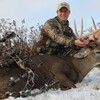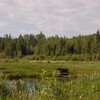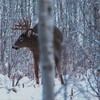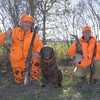
How to Scout, Bait and Place stands to hunt Black Bears

With the Ontario spring bear hunt back in full swing and the fall bear hunt still being an ideal time to hunt, it’s never been a better time to be a bear hunter. With a 17-year stoppage of spring hunting, bear numbers have soared in the province. Bears have been plentiful in almost all Boreal forest regions, and big mature bears are roaming all corners of the province. My family not only loves bear hunting, but we love bear meat. It surprises me how often we hear people saying they don’t eat bear meat or don’t enjoy it. With a bit of research, I promise you will find a bear recipe, or lots of them, that allows you to love bear meat as we do.

Hunting bears can be intimidating for some; they are not deer, and you cannot pattern them to travel routes and feeding on crops like most fringe animals. They are not turkeys or moose who can be called in effectively during the mating seasons. No, bears are totally different, and when hunted on their turf in the dense Boreal forest, they can be ghosts, even though the numbers are high.

To hunt black bears effectively, baiting is the main system used. Baiting is legal in Ontario during the spring and fall seasons, like in most other parts of Canada. But just throwing food out in the woods and hoping bears find it or eat at it consistently is harder than it sounds.
Here are some tips for hunting black bears that we have found to work consistently.
1. Look at topographical maps of the area you're choosing to hunt. Look for natural contours or breaks in the land like you would find travel routes for deer. If there is an area naturally narrowing down travel for animals, then that’s a great location to consider.
2. When placing your bait location, pick your tree stand or ground blind spot first, and get your back to a high ridge, a creek, or a pond where it’s hard for the bears to circle around you to approach the bait. This keeps them coming from the thick cover in front of you and not constantly trying to circle downwind and scent you before you even see them. When choosing a site, think of the predominant wind locations for the time of year you're hunting. For example, August in some areas has more west and southwest. Set up the stand and the bait with the wind in your face blowing over the water or ridge where you do not expect the bear to approach.
3. Decide if you want a gun or a bow stand. Set it up at the appropriate distance. I say, no closer than 20 yards. I like 22 to 25 yards for archery and further for a gun. This gives you the ability to get the bow drawn, take aim, and make subtle movements without being on top of the animal and getting busted, but get close enough for a great, ethical shot.
4. Set up the blind or the tree stand right from the beginning so the bears are used to it.
5. Set up your bait. Many like barrels, and that’s okay. I like logs and rocks. Find or make a small depression and place the bait of choice in it. Then, cover it with large logs, rocks, etc. This does multiple things, but for starters, it keeps small critters from dragging your bait away before bears get to eat. It also creates work for the bear to do when you're hunting and occupies him while you get set for a shot. Often, the bear has to move around shuffling the logs and rocks and will offer a clean, ethical shot in the process.
6. Choose the type of bait you will use. You don’t have to be consistent with this and can mix it up, but if it's working, consistency helps. Bears love many sorts of foods, I suggest a choice that does not rot quickly in the heat and attracts flies.
7. If you’re too busy to visit your bait site regularly, stock it up for long periods of time. Put lots of bait out, creating a food source the bears start to count on. If you can go daily and live nearby, bait daily at the same time or try to do it at the same time as best you can. Never in the evening. Always do this before 4 pm, as that’s when you want them comfortable and not to be scared off for future hunt opportunities.
8. If you have a game camera, set it up at the location.
9. Get your baiting routine down until you feel the right bear you're looking to harvest is coming in.
10. Pick your night to hunt. Try and avoid mornings as you’re walking into a hot zone, and there's a good chance of putting bears off the site. Go in the mid-late afternoon. Pick the right wind. If you have a buddy who can walk in with you and pretend it’s a baiting trip like other days and then leaves once you’re in your position, that is the best bet.

One trick we use during the hunt is to have a spray bottle filled with vanilla; we spray it on leaves and trees around where we are sitting to help cover our scent. If the wind swirls and switches, we spray it during the hunt as well. Bears have poor eyes but live and die by their nose and ears. You can get a bow drawn on a bear much easier than a whitetail, but their nose is hard to trick. Aging and sizing bears is a real challenge, so try to watch the footage and look at lots of pictures of different age classes of bears
It sounds like a lot of work, but it’s extremely enjoyable. It’s extremely rewarding, and it’s amazing table fare. Get out there and hunt more bears as it's part of a management process that helps keep the bear populations at a sustainable, renewable number here in Ontario.
Good hunting!
Recommended Articles

Spring Prospects for Northwestern Ontario Bruins

Long Point Bay

Grousing in Northeastern Ontario
Inside Deer Season

Buck on the Run

Snow Hunt for Grouse
Grouse Hunting at Birch Dale Lodge

Bird Dog Friendly Lodges

Ogoki Moose

Kincardine Turkey

Father and Son

Bear Country

Wild Turkey & A Blind

Bruce County Turkey

Turkey Tales and Turkey Fails

A Hunter's Dream for Grouse
A First-Time Bear Hunter Visits Watson's Kaby Lodge

Northwestern Ontario Whitetail Deer Hunt

Moose Tales


















